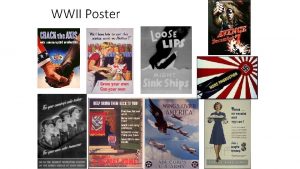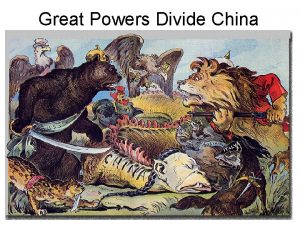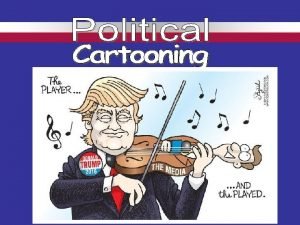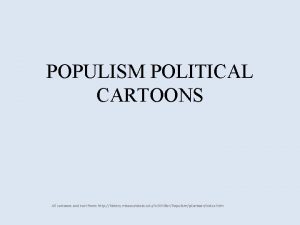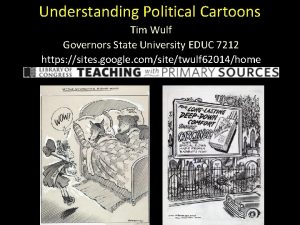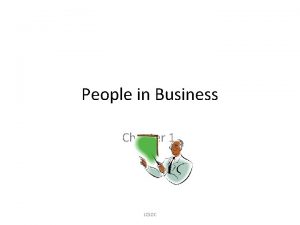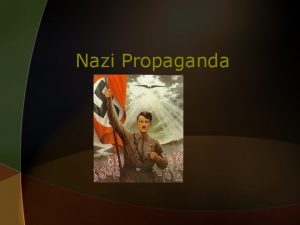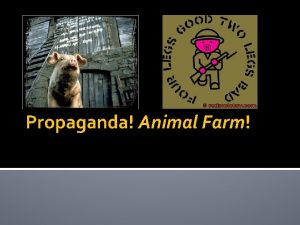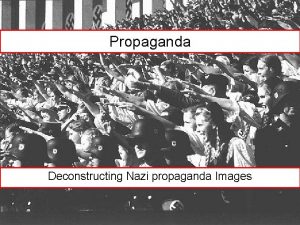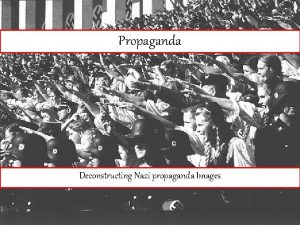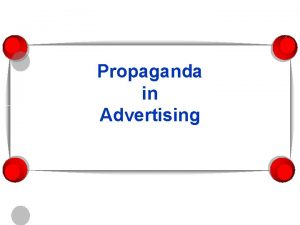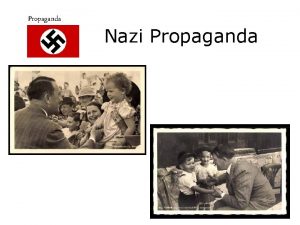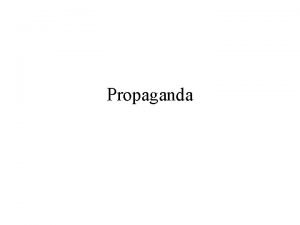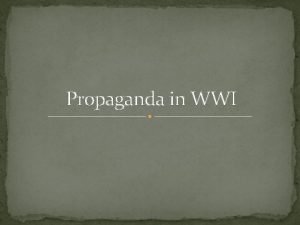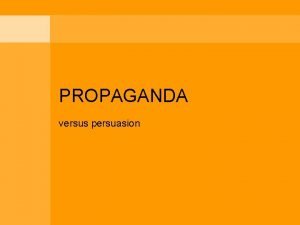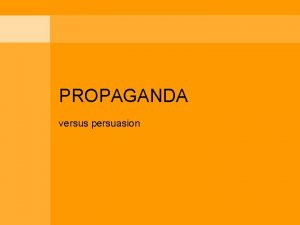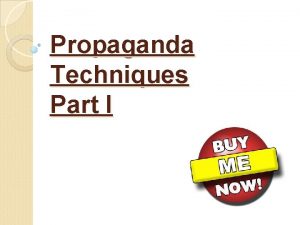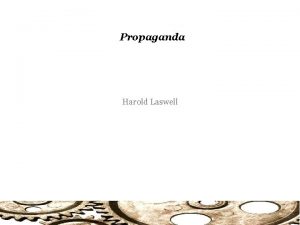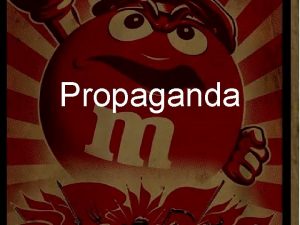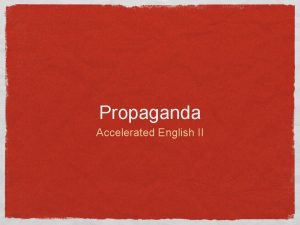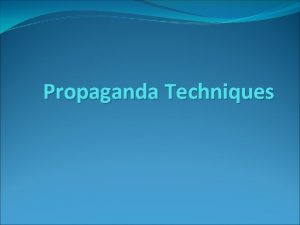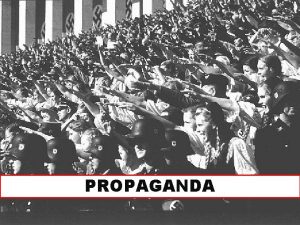PROPAGANDA What is Propaganda Propaganda Political strategy to

































- Slides: 33

PROPAGANDA

What is Propaganda? Propaganda • Political strategy to shape public opinion and behavior • Advertises a cause, organization, or movement • Persuades humans to take action toward a goal • Provides partially true, or just plain false information • Can also include biased information, as well as symbols, images, words, or music that play on emotions

Common Propaganda Techniques • • • Bandwagon Testimonial Plain Folks Transfer Card Stacking Logical Fallacies • Glittering Generalities • Name-calling

This 1 st technique… … is an attempt to convince the public that the candidate’s views reflect those of the “common person, ” and that the candidate appears to be working for the benefit of the “common person. ” a) b) c) d) e) f) g) h) Testimonial Bandwagon Card Stacking Transfer Plain Folks Logical Fallacies Glittering Generalities Name-calling

This 1 st technique… … is an attempt to convince the public that the candidate’s views reflect those of the “common person, ” and that the candidate appears to be working for the benefit of the “common person. ” e) Plain Folks

This 2 nd technique… a) or stories from a well- b) known person to c) endorse a product or d) campaign. e) f) g) h) … is using quotations Testimonial Bandwagon Card Stacking Transfer Plain Folks Logical Fallacies Glittering Generalities Name-calling

This 2 nd technique… … is using quotations or stories from a wellknown person to endorse a product or campaign. a) Testimonial

This 3 rd technique… … sounds as if it a) makes sense, but the b) assumptions given c) for the conclusion do not really provide d) proper support for the e) argument. f) g) h) Testimonial Bandwagon Card Stacking Transfer Plain Folks Logical Fallacies Glittering Generalities Name-calling

This 3 rd technique… … sounds as if it makes sense, but the assumptions given for the conclusion do not really provide proper support for the argument. f) Logical Fallacies

This 4 th technique… … is an appeal to follow the crowd and join the winning team! a) b) c) d) e) f) g) h) Testimonial Bandwagon Card Stacking Transfer Plain Folks Logical Fallacies Glittering Generalities Name-calling

This 4 th technique… … is an appeal to follow the crowd and join the winning team! b) Bandwagon

This 5 th technique… … uses words that a) have different b) positive meanings for c) individuals, but are linked to highly d) valued concepts. e) f) Examples: honor, g) glory, freedom h) Testimonial Bandwagon Card Stacking Transfer Plain Folks Logical Fallacies Glittering Generalities Name-calling

This 5 th technique… … uses words that have different positive meanings for individuals, but are linked to highly valued concepts. Examples: honor, glory, freedom g) Glittering Generalities

This 6 th technique… … only presents information that is positive to an idea or proposal. While the information presented is true, other important information is left out on purpose. a) b) c) d) e) f) g) h) Testimonial Bandwagon Card Stacking Transfer Plain Folks Logical Fallacies Glittering Generalities Name-calling

This 6 th technique… … only presents information that is positive to an idea or proposal. While the information presented is true, other important information is left out on purpose. c) Card Stacking

This 7 th technique… … uses disrespectful words that carry a negative connotation to encourage prejudice and discrimination among the public by labeling and targeting an enemy. a) b) c) d) e) f) g) h) Testimonial Bandwagon Card Stacking Transfer Plain Folks Logical Fallacies Glittering Generalities Name-calling

This 7 th technique… … uses disrespectful words that carry a negative connotation to encourage prejudice and discrimination among the public by labeling and targeting an enemy. h) Name-calling

This 8 th technique… … is an attempt to make you view something in the same way you view something else, by shifting the negative (or positive) feelings you have for one thing to another thing a) b) c) d) e) f) g) h) Testimonial Bandwagon Card Stacking Transfer Plain Folks Logical Fallacies Glittering Generalities Name-calling

This 8 th technique… … is an attempt to make you view something in the same way you view something else, by shifting the negative (or positive) feelings you have for one thing to another thing D) Transfer

Common Propaganda Traits • Uses half-truths or lies • Omits information selectively • Plays on emotions • Advertises a cause • Meant to persuade • Attacks opponents * Targets desired audiences

Nazi PROPAGANDA Themes

National Pride & Community • A major part of Nazi ideology and propaganda • Sought an organic, racial union of all “Aryan” Aryan Germans • Values contributing to the general welfare of the nation, not individualism • Nazi propaganda played a crucial role in selling this myth to Germans who longed for unity, national pride and greatness

Rallying the Nation "Greater Germany: Yes on 10 April" (1938). This election poster emphasizes the message of jumping on the Nazi political bandwagon, as represented by the hands raised in a unified Nazi salute. • The Nazi Party dramatically increased its public support by advertising itself as a protest movement against the “corruption” and ineffectiveness of the Weimar system • Throughout WWII, Nazi propagandists disguised German military aggression as acts of ethnic self-defense necessary for the survival of “Aryan civilization” • Nazi propaganda frequently stressed the power of a mass movement to propel the country forward, symbolized by the upward angle of the hands • This poster typifies the propaganda strategy of using simple, confident slogans with bold graphics and the characteristic Nazi colors of red, black, and white

Convincing Young People • From the 1920 s onwards, the Nazi Party targeted German youth as a special audience for its propaganda messages • These messages emphasized that the Party was: – dynamic – resilient – forward-looking – hopeful – young "Students: Be the Führer's Propagandists. " With militant appeals to nationalism, freedom, and self-sacrifice, the Nazi Party successfully recruited students disenchanted with German democracy and their current student organizations. • Millions of German young people were won over to Nazism by what was taught in the classroom and extracurricular activities, activities like the Hitler Youth

Making a Leader • Nazi propaganda idolized Hitler as a gifted politician who brought stability, created jobs, and restored German greatness • Under the Nazi regime, Germans were expected to pay public allegiance to the “Führer” by giving the Nazi salute and greeting others on the street with “Heil Hitler!” the so-called “German Greeting” Techniques of propaganda -- including strong images and simple messages -- helped propel Austrian-born Adolf Hitler from being a little known extremist to a leading candidate in the 1932 German presidential elections. The style of this poster is similar to some film stars of the era. Election poster, 1932; photo by Heinrich Hoffmann • Faith in Hitler strengthened the bonds of national unity, while open criticism of the Nazis, and their leaders, were grounds for imprisonment

Defining the Enemy • One crucial factor in creating a cohesive group is to define who is excluded from membership • Nazi propagandists contributed to the regime's policies by publicly identifying groups for exclusion, inciting hatred, and cultivating indifference • Propaganda helped to define who would be excluded from the new society and justified persecution against the “outsiders, ” such as: Nazi propaganda often portrayed Jews as engaged in a conspiracy to provoke war. Here, a stereotyped Jew conspires behind the scenes to control the Allied powers, represented by the British, American, and Soviet flags. The caption reads, "Behind the enemy powers: the Jew. " Circa 1942. – – – Jews Sinti and Roma (Gypsies) homosexuals political rebels or anti-Nazis Germans viewed as genetically inferior and harmful to “national health”

Writing the News • Der Stürmer was the most notorious, antisemitic newspaper in Germany and published horrible tales of Jewish “ritual murder, ” sex crimes, and financial wrongdoing • The Nazis also understood the power and attraction of emerging technologies, such as film, loudspeakers, radio, and television "All of Germany Listens to the Führer with the People's Radio. " The poster depicts a crowd surrounding a radio. The radio looms large, symbolizing the mass appeal and broad audience for Nazi broadcasts. • These technologies offered a means for mass communication of their messages and a way to reinforce the myth of the National Community through communal listening and viewing experiences

Deceiving the Public • Propaganda served as an important tool to win over the majority of the German public who had not supported Adolf Hitler and to push forward the Nazis' radical regime • A new state propaganda program, headed by Joseph Goebbels, Goebbels sought to manipulate and deceive the German population and the outside world • Propagandists preached an appealing message of national unity and a utopian future An antisemitic poster published in Poland in March 1941. The caption reads, "Jews are lice; They cause typhus. " This German-published poster was intended to instill fear of Jews among Christian Poles.

Analyze these Nazi propaganda images

“A New People” Political Calendar cover, “A New People 1938, ” Nazi Party Office of Racial Politics USHMM, source unknown

“The Eternal Jew” Exhibition poster, “The Eternal Jew, ” Munich, 1937 USHMM, courtesy of Julius Goldstein

“Germany’s Victory, Europe’s Freedom” Wartime poster, “Germany’s Victory, Europe’s Freedom”, 194? USHMM, source unknown

 Porter’s diamond of national advantage
Porter’s diamond of national advantage Strategy formulation corporate strategy
Strategy formulation corporate strategy Chase aggregate plan example
Chase aggregate plan example Masterful strategies come from
Masterful strategies come from Multinational strategy vs global strategy
Multinational strategy vs global strategy Multidomestic marketing strategy
Multidomestic marketing strategy The plan of action that prescribes resource allocation
The plan of action that prescribes resource allocation Business strategy vs corporate strategy
Business strategy vs corporate strategy Aligning hr strategy with business strategy
Aligning hr strategy with business strategy Listening strategies activities
Listening strategies activities Strategy and organization in the international firm
Strategy and organization in the international firm Propaganda technique loaded words
Propaganda technique loaded words Bandwagon propaganda pictures
Bandwagon propaganda pictures Plain folks persuasive technique
Plain folks persuasive technique Propaganda movement members
Propaganda movement members Robber baron political cartoon
Robber baron political cartoon Gayatri spivak
Gayatri spivak Message behind
Message behind Chinese dragon political cartoon
Chinese dragon political cartoon Nullification crisis political cartoon
Nullification crisis political cartoon Political management in strategic triangle
Political management in strategic triangle Political socialization cartoon
Political socialization cartoon Populist party political cartoon
Populist party political cartoon Political cartoons
Political cartoons Political wish
Political wish Political sophistication
Political sophistication Australian physical features
Australian physical features Developing world definition
Developing world definition Sarvesh suri
Sarvesh suri Political
Political Swana
Swana Political vocabulary
Political vocabulary Chapter 23 political paralysis in the gilded age
Chapter 23 political paralysis in the gilded age Define political cartoon
Define political cartoon












